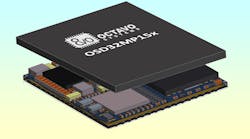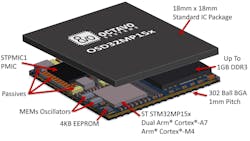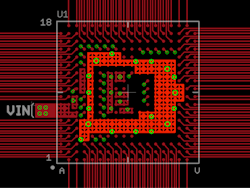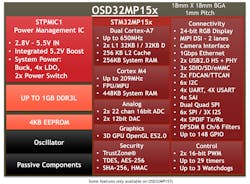STMicroelectronics’ STM32MP1 is a great multicore system-on-chip (SoC), but it takes more than a PCB to make it work. To that end, Octavo Systems combines this SoC with all of the needed components into a system-in-package (SiP) solution—the OSD32MP1 (Fig. 1). This 18- × 18-mm package is about the same size as the chip, but provides significant advantages including PCB design simplification plus matching the SoC with the required clocking and power support. It also houses 1 GB of DDR3L memory and 4 kB of EEPROM. A low-cost serial flash chip is one option for nonvolatile storage.
1. The OSD32MP1 packs in passives and support electronics needed by STMicroelectronics’ STM32MP1 multicore SoC into an 18- × 18-mm package.
The footprint reduction is significant (Fig. 2). A tiny serial flash chip for program storage is all that’s needed to complete the system. This approach allows designers to create a very compact system while letting the designers select the amount for off-chip storage needed for an application. The 650-MHz dual-core Cortex-A7 can run operating systems like Linux. The 209-MHz Cortex-M4 will typically run an RTOS or a bare-bones application.
2. The design savings provided by using the OSD32MP1 is significant, plus it offers a major footprint reduction.
The SIP design was optimized for PCB layout by having all major signals on the periphery. They’re also designed to fan out to other interfaces of chips in an optimal fashion to easily achieve a four-layer PCB design (Fig. 3).
3. Octavo doesn’t mirror the more random pinout of the SMT32MP1. Instead, it’s specifically designed to minimize PCB routing issues, allowing the large BGA to be used with four-layer PCBs.
The major PCB layout complexity when using the STM32MP1 concerns the other high-speed components like the DRAM. System design must also match the passive and other active support like power management and clock support without major overkill in the design while keeping the overall system small and power efficient. Octavo has taken on those design chores, allowing developers to concentrate on the application while simplifying PCB design as well.
The STM32MP1 provides the OSD32MP1 with a substantial digital and analog framework (Fig. 4). The dual-core Cortex-A7s share 256 kB of system RAM while the Cortex-M4F has its own 448 kB. The analog component includes dual, 22-channel, 16-bit ADCs and dual 12-bit DACs. The 3D GPU supports OpenGL ES2.0. It has plenty of timers and PWM support along with a plethora of connectivity features including 1-Gb Ethernet and dual FD-CAN/TT-CAN.
4. The OSD32MP1 adds 1 GB of DDR3L and 4-kB EEPROM along with all of the necessary power, clock, and passives needed to support the STM32MP15x family, which is based around a dual-core Cortex-A7 and a Cortex-M4.
The ARM TrustZone security provides secure boot and hardware crypto acceleration. STMicroelectronics has also certified the STM32MP1 with ARM’s Platform Security Architecture (PSA). This includes the API support, providing developers with a standard security interface to the underlying hardware.






